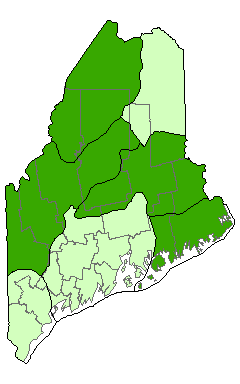DACF Home → Bureaus & Programs → Maine Natural Areas Program → Communities, Plants, and Animals → Natural Community Fact Sheets → Blueberry Barren
Printer Friendly Fact Sheet - 740 KB pdf (Get a free copy of Adobe Acrobat Reader)
Blueberry Barren
Scientific Name: Blueberry - Lichen Barren; State Rank: S2
- Community Description
- Soil and Site Characteristics
- Diagnostics
- Similar Types
- Conservation, Wildlife and Management Considerations
- Distribution
- Characteristic Plants
- Associated Rare Plants
- Associated Rare Animals
- Examples on Conservation Lands You Can Visit
Community Description: These barrens are wide, flat to hummocky expanses of dwarf shrub vegetation punctuated by sparse pine or spruce trees. Lowbush and/or velvet-leaf blueberry is the predominant shrub, forming a fairly even carpet. Herbs are sparse. In patches among the shrubs, reindeer lichens may form extensive carpets. The characteristic expression of this community is as an opening within woodland barrens such as Pitch Pine - Scrub Oak Barrens or Black Spruce Barrens; smaller openings (e.g., less than an acre) would be considered inclusions, but larger ones should be segregated as this non-wooded type. Back to top.
Soil and Site Characteristics: Coarse textured glacial outwash deposits form a flat to undulating substrate that can encompass a wide moisture gradient. Xeric conditions on hummocks or raised areas can grade into bog-like vegetation in depressions. Soils are highly acidic and nutrient poor. Sites are typically found in areas where fire has been frequent. Lichen carpets may be characteristic after particularly hot fires. Back to top.
Diagnostics: Lowbush blueberry is dominant, lichens are abundant, and conifers and other trees sparse. Back to top.
Similar Types: Sandplain Grasslands are more common southward and lack the abundant lichens and feature little bluestem grass as a local dominant. Pine and spruce barrens (Pitch Pine - Scrub Oak Barrens, Pitch Pine - Heath Barrens, Black Spruce Barrens) are closely related, but have more tree cover. Back to top.
Conservation, Wildlife and Management Considerations: Many former natural occurrences of this type have been converted to actively managed blueberry barrens in Downeast Maine. While these managed barrens maintain some superficial resemblance to natural barrens, pesticide use may have changed their species composition Both of the documented occurrences of this type are on state-owned or private conservation land.
Managed blueberry barrens provide some of the best habitat in the northeast for the rare upland sandpiper and other ground-nesting species like the rare short-eared owl. The whimbrel, a non-breeding migrant shorebird, uses near-coastal barrens for foraging. The graceful clearwing, a butterfly that which feeds on blueberries in its larval phase, is formerly known from Maine and may have inhabited examples of this community within pitch pine barrens. Back to top.
Distribution: Natural occurrences are known only from Downeast and extreme northwestern Maine; poorly documented. Landscape Pattern: Small Patch. Back to top.


Characteristic Plants: These plants are frequently found in this community type. Those with an asterisk are often diagnostic of this community.
- Sapling/shrub
- Gray birch
- Red pine
- White pine
- Dwarf Shrub
- Black chokeberry
- Lowbush blueberry*
- Meadowsweet
- Sheep laurel
- Sweetfern
- Herb
- Bracken fern
- Wintergreen
- Bryoid
- Awned hair-cap moss
- Juniper hair-cap moss
- Red-stemmed moss
- Reindeer lichen*
- Short-eared owl
- Upland sandpiper
- Whimbrel
Examples on Conservation Lands You Can Visit
| Example | County |
|---|---|
| Nicatous Public Lands | Hancock Co. |
| St. John River Preserve | Aroostook Co. |